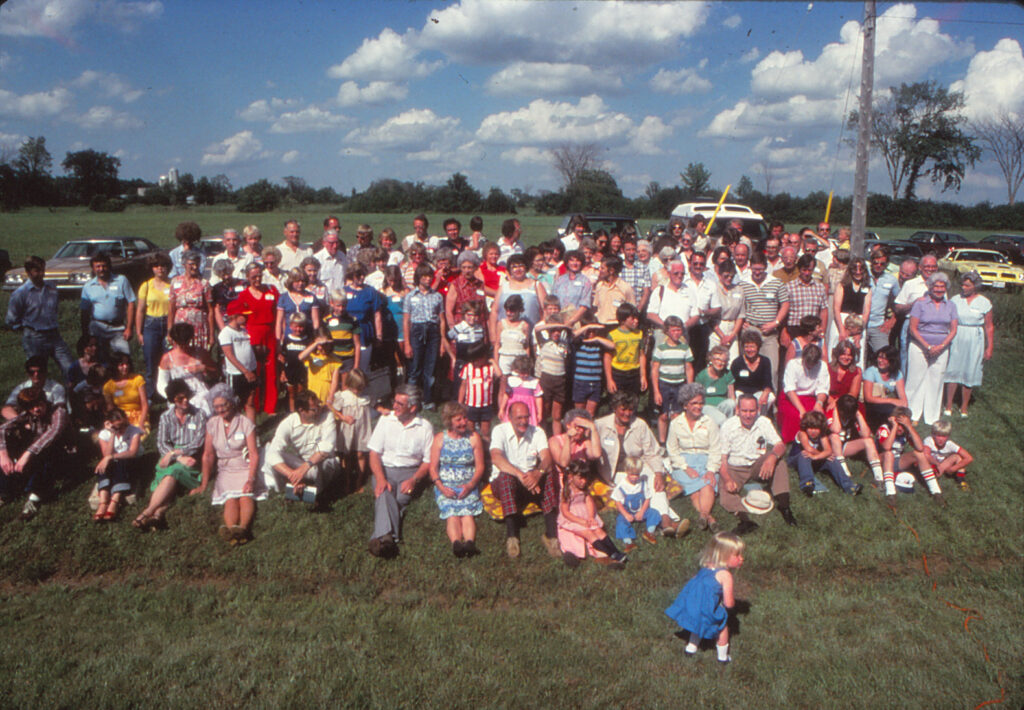Family History & Genealogy
“If poetry is emotion recalled in tranquility, then history is the imagination disciplined with facts.” Bede

In the photo, front row, right side, Irene Miller and Ernest Miller, my father (back to camera); Second Row, right side, Great Grandmother Eliza Dodds, Irma Miller, Alice Whyte Ferrier Miller, my Grandmother (holding Irma). I wonder who the others are???
I participated in my first Miller family picnic about 1948 when descendants of William Miller and Margaret Burns decided to gather at Silver Lake near Perth. I understand that the occasion was prompted by a relative visiting from afar. It was decided to make this gathering an annual event. Although the waters of the lake, the sand beach and the doting aunts were of more interest at that time, it wasn’t too many years until I would eavesdrop on the stories told by elders as they sat around the picnic area.
It was only in the 1970’s, when Algonquin College offered extension courses throughout the counties surrounding Ottawa, that my interest turned to more formal research of my heritage. While taking courses in genealogy studies led by Viola Reid, many hours were spent in front of microfiche readers and combing family papers. Archives and museums became familiar haunts. Bits of family lore were documented.
In the beginning the story I sought was about William Miller and Margaret Burns who emigrated to Dalhousie township, Lanark County, Ontario in 1820. It later extended back a generation to William’s parents, William Miller senior and his wife Elizabeth Gilmour. Their stories began in Scotland and, over a period of 200 years or more, evolved into a saga of North American and Australian settlement as family members scatter around the world.
During the 1980’s I returned to formal learning and graduated with a degree in Canadian Studies from Carleton University in 1985. Formal studies in history, sociology, politics were immediately used when I assumed a position with the Mississippi Valley textile museum project in Almonte. During this period, I became immersed in the history of the Mississippi river valley, and especially in the history of the town of Almonte, now found in Mississippi Mills, Ontario.
I found myself busy during these years. Life with a young family and as partner on a multi-facetted farm, I had little time for family research. I gave my early research to my father, Ernest Miller, who was newly retired and looking for activities. Dad took my early efforts and, in addition to co-publishing many indices for microfilms used by other researchers, he published a Miller family genealogy for a few of the branches of the Miller family in 1993. In 1997, when he passed away, my research and Dad’s research came to me. I am still sorting through it! Today, my research has expanded and now encompasses many paternal and maternal family lines, all with roots in Lanark County. My focus is on recording, not only their statistics, but also stories and pictures for everyone.
In 2014 I ‘split’ my database and my husband Don joined me in the pursuit of family history. Don has assumed responsibility for his family story, and I for mine. Between us, our research encompasses many of the families of Lanark County and often extends beyond its borders. Our research tracks the movement of each family across Canada and the United States, and occasionally as far afield as Australia. More recently, I expanded my research from ‘family’ to ‘community’ research as I explore the intertwining of many families who settled in the Bathurst District beginning in 1816.
I have recently published two books, Tayside Memories: The Story of a Lanark County Lad, the memoires of her father J.R. Ernest Miller and Janet’s Legacy: Janet Millar Callander 1812-1895. I publish under the name Diane Miller Duncan. More details on these publications can be found in the blog postings. Two additional manuscripts are in the works.
It is hoped that many relatives and friends will find their way to this blog – a place to share pictures and stories, to encourage others to fill in those ‘blanks’ on the family tree, and to break down those ‘brick walls’ that we all have in our research. Those who do not share kinship, may find some clues among the neighbours and friends of people in our family lines. If we can help, we would love to do so.
Diane Duncan

